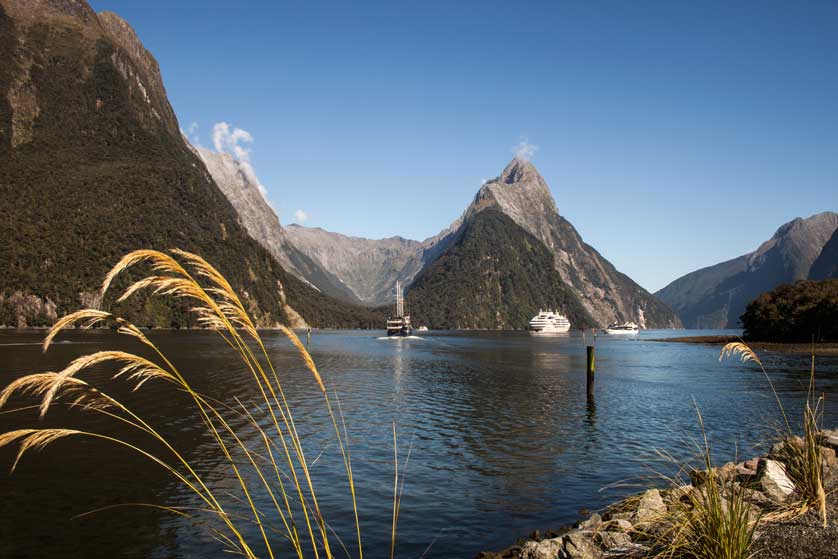Fiordland National Park, New Zealand
 |
| Fiordland, New Zealand |
Fiordland National Park on the southwest tip of South Island, is the largest of New Zealand's 13 national parks. It occupies most of the southwest corner of the South Island and is a UNESCO World Heritage Site. The natural landscape here is one of beautiful forests, fiords, glaciers, mountains and valleys. Again, walking trails crisscross the area allowing access to some of the most striking natural scenery in the country.
The park covers an area of 12,607 square kilometres (4,868 square miles). It was established in 1952.
 |
| The stunning scenery of Fiordland National Park, South Island |
Attractions
The park's most iconic feature is its stunning fiords, which were carved by glaciers over thousands of years. The most famous of these is Milford Sound, renowned for its towering cliffs, cascading waterfalls, and tranquil waters.
Other notable fiords in the park include Doubtful Sound and Dusky Sound. These fjords offer breathtaking scenery and are often regarded as some of the most beautiful natural attractions in the world.
The diverse landscapes of Fiordland National Park include rugged mountains, ancient rainforests, lakes (Lake Hauroko is the deepest in New Zealand at 462 metres), and rivers. The park is home to numerous native plant and animal species, some of which are unique to New Zealand. The native birdlife is particularly impressive, with species such as the endangered takahe, kea (a playful alpine parrot), and the kiwi, New Zealand's iconic flightless bird.
Fiordland is a paradise for outdoor enthusiasts and adventurers. It offers a wide range of activities, including hiking, kayaking, boating, fishing, and wildlife spotting. The park is crisscrossed by a network of hiking trails, the most famous of which is the Milford Track, often referred to as "the finest walk in the world." This four-day trek takes hikers through awe-inspiring landscapes, including mountains, lakes, and waterfalls including Sutherland Falls, at 580 meters the highest in New Zealand.
In addition to its natural wonders, Fiordland National Park also has a rich human history. The area was traditionally inhabited by Maori, the indigenous people of New Zealand, who cherished the land and its resources. European exploration and settlement brought new influences to the region, and remnants of early human settlements can still be found.
The Department of Conservation (DOC) Visitor Centre is at Lakefront Drive, Te Anau 9600. Tel: 03 249 7924; May to October open Monday to Saturday from 9 am - 4 pm, closed for lunch 12 - 1 pm. Closed Sunday; November to April: 8.30 am - 4.30 pm daily.
 |
| DOC Sign |
Accommodation
Try Kingsgate Hotel Te Anau next to Lake Te Anau.
The four-star Distinction Luxmore Hotel has a fitness centre and free WiFi.
The Fiordland Hotel provides both en suite bathrooms and tea and coffee-making facilities.
Find accommodation in Te Anau.
Access - Getting There
Access to Fiordland National Park can be challenging due to its remote location and rugged terrain. However, there are several ways to reach the park and explore its stunning landscapes.
The closest major airports to Fiordland are Queenstown Airport and Invercargill Airport. Queenstown Airport is approximately 170 kilometers (105 miles) northeast of the park, while Invercargill Airport is about 180 kilometers (112 miles) southeast. From these airports, you can rent a car or join organized tours to travel to Fiordland. Queenstown Airport has flights from Wellington International Airport (WLG), Auckland Airport (AKL) and Christchurch.
In addition, there are international flights to Sydney, Melbourne, Brisbane, and the Gold Coast operated by Air New Zealand, Jetstar, Qantas and Virgin Australia.
If you prefer to drive, the town of Te Anau, located on the shores of Lake Te Anau, serves as the gateway to the park. Te Anau is approximately a two-hour drive from Queenstown and a three-hour drive from Invercargill. From Te Anau, you can continue your journey to various destinations within the park.
Several bus services operate between major towns and cities in New Zealand, including Queenstown, Te Anau, and Invercargill, and provide transportation to Fiordland National Park. These buses often offer flexible schedules and are a convenient option for travelers who prefer not to drive.
The fiords themselves can be accessed by boat. Cruises depart from Milford Sound and Doubtful Sound, providing visitors with an opportunity to explore the scenery up close.
 |
| Milford Sound |
Books on New Zealand





0 Comments